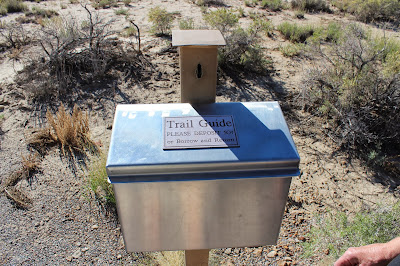
Round Trip Distance: 0.3 miles
Difficulty: Easy
Elevation: 6104 - 6112 feet
Cellphone: 0 bars
Time: 30 mins.
Trailhead: Pueblo del Arroyo
Fee: $8/vehicle
Attractions: Chacoan great house
Pueblo del Arroyo is located in the Chaco Culture National Historical Park in northwestern New Mexico. Pueblo del Arroyo, Spanish for 'Village by the Wash', is a large Chacoan great house that had roughly 300 rooms and 17 kivas making it the fourth largest of the great houses. A rare tri-walled structure and an east facing plaza set Pueblo del Arroyo apart from other Chacoan great houses that typically have a south facing plaza.
The Pueblo del Arroyo trailhead is at the westernmost point of the Canyon Loop Drive road.
Trail brochures are available for purchase for 50 cents at the Visitor Center and at the trailhead. At the trailhead the guides may also be borrowed and returned. While the brochures at each of the sites has valuable information for that particular venue they also contain interesting facts about the area in general that isn't necessarily repeated in all of the brochures. Visitors are greatly enriched by reading each and every one of the guides at all of the sites. To avoid getting to a location and finding the box empty you might consider purchasing one of each at the Visitor Center when you arrive at Chaco Canyon.
While the trail isn't designated as wheelchair accessible it is hard packed and wide enough to accommodate one if someone is providing assistance. There are a few spots where there are stairs that would have to be skipped but a cursory visit would still be possible.
To stay in sync with the brochure continue along the west wall of the ruin to the first numbered post.
A rare triple walled structure is found at stop number 2. Unlike most other tri-wall structures this one doesn't enclose a kiva. Nevertheless it is believed that it was used for ceremonial purposes.
It seems interesting for a people that worked so much with stone that they used the same wooden design for their lintels as though it had some special significance. If large stones had been used above the doors and windows perhaps more walls would still be standing. Many of these structures were burned with fire which may have weakened or destroyed the lintels causing the center area of the walls to collapse like so many of them have.
These 'T' shaped doors are a common style used throughout the ancestral Puebloan architecture in the southwest and even down into Mexico. They appear to serve no other purpose than to be symbolic in nature.
At one time these walls reached as high as 4 stories. There are many towns in the region that don't have buildings that big to this day.
The skeletons of 3 scarlet macaws were found in a rectangular room that appeared to have been used as a pen. The birds are native to Mexico and Central America where they are still prized for their colorful feathers. Macaws and parrots are examples of trade items that were exchange between the Chacoans and the people further to the south in what is present day Mexico.
A keyhole kiva shows ties with Mesa Verde and other areas to the north. Many people seem under the impression that because they never had horses or modern conveyances that this people never traveled very far. In reality they brought timbers from 60-70 miles away and traded with other people many hundreds of miles away. They may have had hunting trips that took them to great distances also, although we did see 2 herds of elk while we were within the parks boundaries.
Due to inclimate weather we only had one day to spend in Chaco Canyon. In that time we visited 9 sites and hiked about 14 miles. A visit of 2-3 days would be much more suitable. Besides having enough time to visit all of the sites and hike all of the backcountry trails it would allow for a more thorough and relaxing study of each site. There is much more to take in at locations like Pueblo del Arroyo than just stone walls and kivas. If you would like to see it for yourself then all you have to do is 'Take a hike'.













